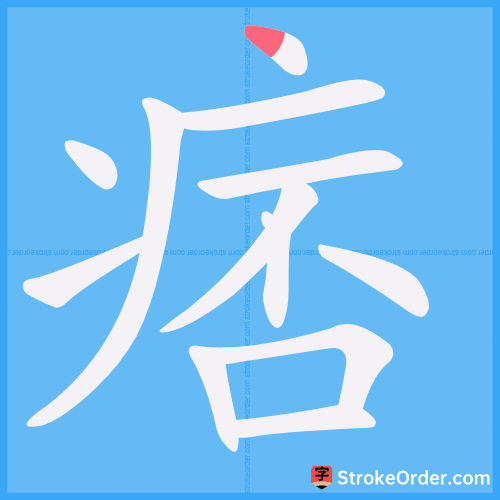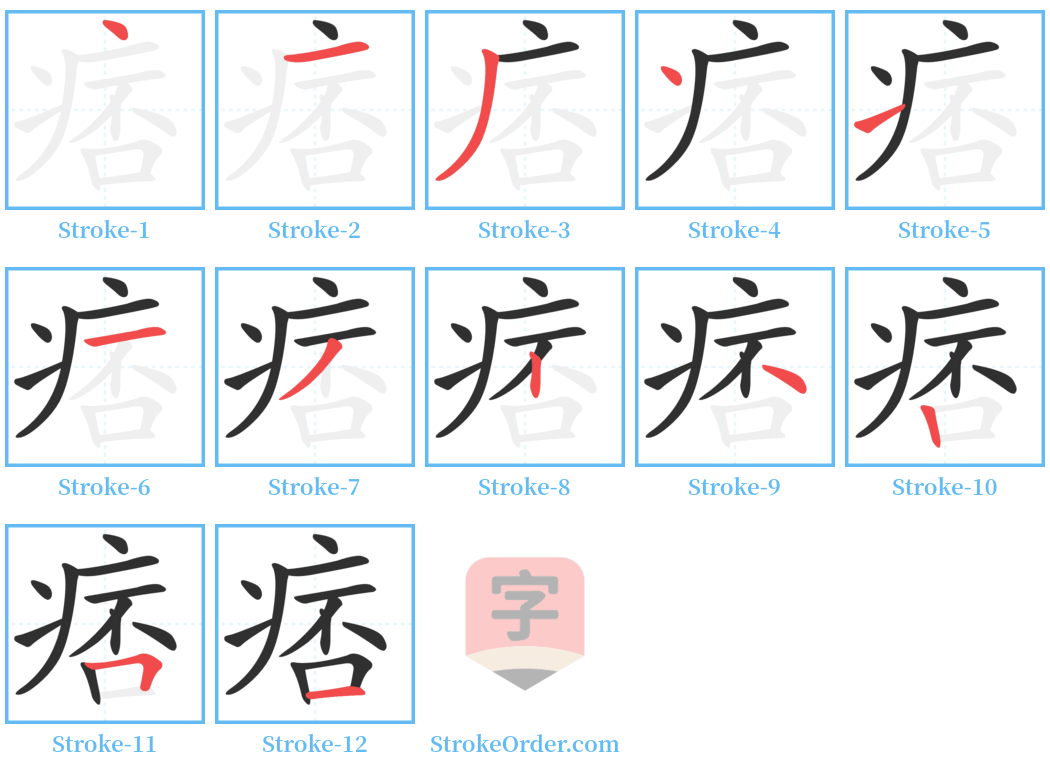痞 Stroke Order
Animated Stroke Order of 痞

Stroke Order Diagrams for 痞

Step-by-Step Handwriting Guide for 痞

Learn to Write Chinese Characters with Video Tutorials
Watch the video of writing the Chinese character "痞", learn the correct stroke order (笔顺) of the character "痞", and master the standard way of writing the character "痞".
Free Printable Handwriting Practice with Stroke Order: 痞
Printable Writing Practice Worksheet of "痞" in Portrait Orientation (Tian Zi Ge)

Printable Writing Practice Worksheet of "痞" in Landscape Orientation (Tian Zi Ge)

Information of 痞
Pinyin
pǐ
Radical
疒
Strokes
12 strokes
Usage
★★★★
Definition
swelling of the liver
痞 [pǐ]
1. In Traditional Chinese Medicine, it refers to a self-perceived symptom of blocked and unrelieved Qi between the chest and abdomen, where some may only feel fullness, referred to as "痞块" (pǐ kuài) or "痞积" (pǐ jī).
(In English: A self-perceived symptom of blocked and unrelieved Qi in the chest and abdomen, with some only feeling fullness, known as "lump in the abdomen.")
2. Scoundrel, ruffian.
(In English: Ruffian, hooligan.)
---
痞 [pǐ]
(Verb, Noun)
- **Original meaning**: A term for a medical condition characterized by a lump or blockage in the chest.
- **Character construction**: Phonetic-meaning compound, with 疒 (chuáng, "sick") and 否 (pǐ, "no").
1. Same as original meaning (In English: Lump in the abdomen).
**Reference**:
From "Shuowen": 痞 means pain. The pain is the result of blockage in the abdomen.
**Examples**:
- 痞利 (pǐ lì): lump causing diarrhea;
- 痞气 (pǐ qì): a condition of the spleen with a lump (i.e., chronic spleen enlargement);
- 痞疾 (pǐ jí): a disease causing a lump in the abdomen;
- 痞硬 (pǐ yìng): a hard lump due to Qi stagnation;
- 痞胀 (pǐ zhàng): fullness caused by stagnation;
- 痞结 (pǐ jié): blockage causing a lump in the abdomen; metaphorically refers to obstruction;
- 痞塞 (pǐ sè): blockage and stagnation;
- 痞满 (pǐ mǎn): a feeling of fullness and discomfort.
2. Scoundrel; ruffian.
**Examples**:
- 地痞 (dì pǐ): local bad elements;
- 兵痞 (bīng pǐ): soldier ruffian;
- 文痞 (wén pǐ): literary scoundrel;
- 痞徒 (pǐ tú): ruffian; villain.
---
痞 [pǐ]
(Adjective)
- To speak vulgar language or engage in indecent behavior in public (In English: Rascally).
Example: 你别痞 (Don't be rascally).
Input Method for 痞
Pinyin
pi3
Wubi
ugik|udhk
Cangjie
kmfr
Zhengma
tgj
Four Corner
00169
Unicode
U+75de
Same Pronunciation Characters